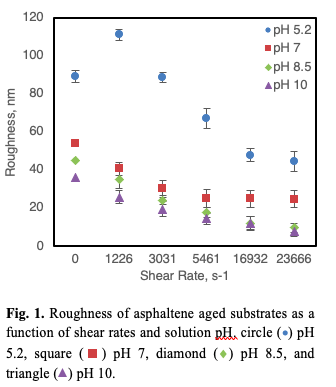(349i) Colloidal Interaction of Asphaltene with Silica Surfaces
AIChE Annual Meeting
2020
2020 Virtual AIChE Annual Meeting
Engineering Sciences and Fundamentals
Poster Session: Interfacial Phenomena (Area 1C)
Wednesday, November 18, 2020 - 8:00am to 9:00am
The removal of asphaltene can be achieved by chemical (solvents, detergents, and polymers), thermal, or mechanical means. However, solvent removal and thermal treatments are not widely accepted due to toxicity reasons and high operational costs. The aim of this study is to develop an insight about asphaltene removal through mechanical mode using shear forces, assistive with pH alterations and ionic surfactants. The colloidal forces between asphaltene-asphaltene and asphaltene-silica are compared against the shear forces to estimate for suitable mechanism of removal.
The deposition of asphaltene is observed on glass slides which serve as proxy material for silica found in the crude oil systems. The clean glass slides are aged in dispersions of asphaltene in n-heptane at definite concentrations. The aging is carried out under continuous stirring operations for specific time periods at pre-defined temperatures. The extent of deposition of asphaltene on the glass slides is examined through atomic force microscopy. The analysis of height sensor and phase images, which depicts the surface morphology and variations in roughness of the substrates, is associated with the amount of asphaltene present on the surface. The removal of asphaltene from the aged substrates is observed in a stainless steel fabricated parallel plate channel. The effect of shear forces on removal of asphaltene with DI water is defined in terms of reduction in roughness of substrates as a function of shear rates. The efficiency of removal is also compared for systems with pH alterations and surfactants addition.
The miniscule roughness of around a nanometer for a clean glass slide increased to about 35 nm upon aging in asphaltene dispersions for 24 hours. The wider range of phase angle and significant variation in the image contrast observed from phase images confirms the presence of a second component (asphaltene) on the surface of the glass slides. When asphaltene aged substrates are initially brought in contact with water a further increase in roughness is observed for all such substrates. Fig. 1 reports the roughness of substrates on which impact of shear forces are observed. The four different curves show results for removal observed at pH 5.2, pH 7, pH 8.5, and pH 10. It is evident from the results that the reduction in roughness is achieved as a function of increasing shear rates and also with increasing pH. The cross-section analysis performed on height sensor images to obtain height distribution of particles also suggest removal of asphaltene from the surface.
The interpretation of the results are explained on the basis of interaction forces. The deposition of asphaltene occurs due to colloidal forces between asphaltene and silica. The dominant adhesive forces could be a result of attractive van der Waal forces and preferential affinity of asphaltene towards silica in a non-polar heptane system. The initial increase in surface roughness when asphaltene aged substrates are contacted with water is due to reorientation of asphaltene particles on the surface. This reorientation results from diffusion of water molecules and interactions with polar asphaltene groups and also inherent of hydrophobic interactions.
As the shear forces are increased, the large aggregates on the surface are weathered and subsequently removed with the flow. The theoretical estimation of forces assuming asphaltene to be a rigid spherical particle suggests that rolling of particles as a result of acting drag force results in removal from the surface. However, the complete removal is not achieved because of higher magnitudes of adhesion force between asphaltene and silica.
The asphaltenes examined in the study exhibits a range of zeta potential from positive to negative over a pH 2 to pH 10. The iso-electric point (IEP), i.e., point of zero charge exists at pH 5.2. The zeta potential for glass slide remains negative for the entire range of observed pH. As the pH of the system is increased during the removal experiments, the asphaltene particles experience greater repulsion from the neighbouring particles and also from the surface. Therefore the efficiency of removal is enhanced upon increasing the pH.
The anionic and cationic surfactants are also tested for their relative efficiency in asphaltene removal. The surfactants adsorb on the asphaltene forming a complex that exhibits a lower interfacial tension which suffices the removal efficiency. The cationic surfactant adsorbs on both negatively charged asphaltene and silica due to electrostatic interactions imparting positive charge to both. The similar polarities in zeta potentials offers repulsion between asphaltene and silica. The removal efficiency is further enhanced with use of cationic surfactants.
The aim of the project is to contribute to both scientific community and the industries. The methods suggested can be implemented to similar systems where either deposition or removal of colloidal particles is the purpose. Referring to the original problems caused due to asphaltene, the project suggests ways to effectively remove asphaltene by means mentioned in the study.
